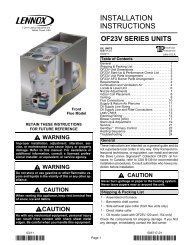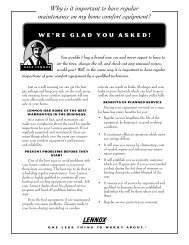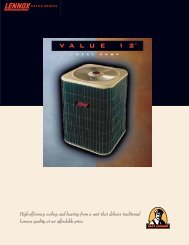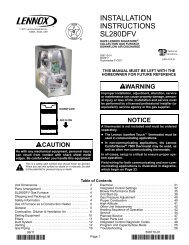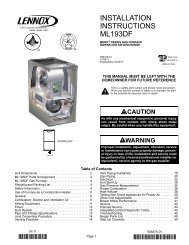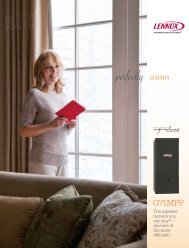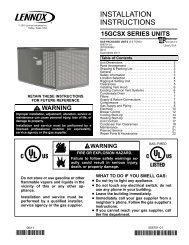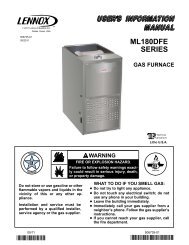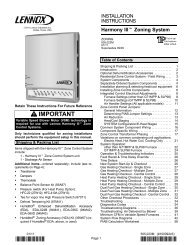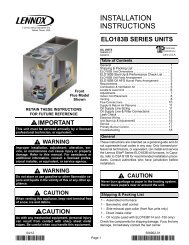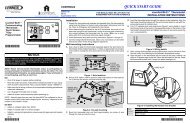G71MPP SERIES - Lennox
G71MPP SERIES - Lennox
G71MPP SERIES - Lennox
You also want an ePaper? Increase the reach of your titles
YUMPU automatically turns print PDFs into web optimized ePapers that Google loves.
2008 <strong>Lennox</strong> Industries Inc.<br />
Dallas, Texas, USA<br />
505,335M<br />
03/2009<br />
Supersedes 03/2008<br />
<strong>G71MPP</strong><br />
<strong>SERIES</strong><br />
VARIABLE<br />
CAPACITY<br />
GAS FURNACE<br />
Litho U.S.A.<br />
WARNING<br />
FIRE OR EXPLOSION HAZARD.<br />
Failure to follow safety warnings exactly<br />
could result in serious injury, death,<br />
or property damage.<br />
Do not store or use gasoline or other<br />
flammable vapors and liquids in the<br />
vicinity of this or any other appliance.<br />
Installation and service must be performed<br />
by a qualified installer, service<br />
agency or the gas supplier.<br />
03/09<br />
<br />
WHAT TO DO IF YOU SMELL GAS:<br />
Do not try to light any appliance.<br />
Do not touch any electrical switch; do not<br />
use any phone in your building.<br />
Leave the building immediately.<br />
Immediately call your gas supplier from a<br />
neighbor’s phone. Follow the gas supplier’s<br />
instructions.<br />
If you cannot reach your gas supplier, call<br />
the fire department.<br />
505,335M
<strong>G71MPP</strong> Parts Identification<br />
TOP CAP<br />
DURALOK TM HEAT<br />
EXCHANGER<br />
ASSEMBLY<br />
BURNERS<br />
CABINET<br />
UPPER ACCESS<br />
PANEL<br />
COMBUSTION AIR<br />
PROVING<br />
(PRESSURE)<br />
SWITCHES<br />
GAS VALVE<br />
AND MANIFOLD<br />
FLUE<br />
COLLAR<br />
VARIABLE SPEED<br />
COMBUSTION AIR<br />
INDUCER<br />
PRESSURE SWITCH<br />
ASSEMBLY<br />
SURELIGHT ®<br />
INTEGRATED<br />
CONTROL<br />
BLOWER ACCESS<br />
PANEL<br />
CONTROL BOX<br />
VARIABLE SPEED<br />
BLOWER<br />
MOTOR<br />
FIGURE 1<br />
NOTE − This manual is the property of the homeowner<br />
and must be left with the equipment user.<br />
Notice to Homeowner<br />
This furnace is equipped with safety devices that protect<br />
you and your property. If one or more of these devices is<br />
activated, furnace operation will stop. If your home is left<br />
unattended for an extended period of time, equipment operation<br />
must be checked periodically. If this is not possible,<br />
the water supply to the house should be shut off and the<br />
pipes should be drained. This will prevent problems associated<br />
with a NO HEAT condition (frozen pipes, etc.)<br />
WARNING<br />
Before attempting to perform any service or maintenance,<br />
turn the electrical power to unit OFF at the<br />
disconnect switch.<br />
WARNING<br />
Product contains fiberglass wool.<br />
Disturbing the insulation in this product during<br />
installation, maintenance, or repair will expose you<br />
to fiberglass wool. Breathing this may cause lung<br />
cancer. (Fiberglass wool is known to the State of California<br />
to cause cancer.)<br />
Fiberglass wool may also cause respiratory, skin,<br />
and eye irritation.<br />
To reduce exposure to this substance or for further<br />
information, consult material safety data sheets<br />
available from address shown below, or contact your<br />
supervisor.<br />
<strong>Lennox</strong> Industries Inc.<br />
P.O. Box 799900<br />
Dallas, TX 75379−9900<br />
Page 2
CAUTION<br />
Do not set thermostat below 60°F (16°C) in heating<br />
mode. Setting thermostat below 60°F (16°C) reduces<br />
the number of heating cycles. Damage to the unit<br />
may occur that is not covered by the warranty.<br />
WARNING<br />
If overheating occurs or if gas supply fails to shut off,<br />
shut off the manual gas valve to the furnace before<br />
shutting off electrical supply.<br />
WARNING<br />
Do not use this furnace if any part has been underwater.<br />
A flood−damaged furnace is extremely dangerous.<br />
Attempts to use the furnace can result in fire or<br />
explosion. Immediately call a licensed professional<br />
service technician (or equivalent) to inspect the furnace<br />
and to replace all gas controls, control system<br />
parts, and electrical parts that have been wet or to replace<br />
the furnace, if deemed necessary.<br />
NOTICE<br />
Any additions, changes, or conversions required in<br />
order for the appliance to satisfactorily meet the application<br />
needs must be made by a licensed professional<br />
installer (or equivalent) using factory−specified<br />
and approved parts.<br />
WARNING<br />
Improper installation, adjustment, alteration, service<br />
or maintenance can cause property damage, personal<br />
injury or loss of life. Installation and service must<br />
be performed by a licensed professional installer (or<br />
equivalent), a service agency, or the gas supplier.<br />
Safety Instructions<br />
1 − Keep the furnace area clear and free of combustible<br />
material, gasoline, and other flammable vapors and<br />
liquids. If it is installed in an insulated area, the furnace<br />
must be kept free of insulating material. Insulating material<br />
may be combustible.<br />
2 − After any heavy snow, ice or frozen fog event, the furnace<br />
vent pipes may become restricted. Always check<br />
the vent system and remove any snow or ice that may<br />
be obstructing the plastic intake or exhaust pipes.<br />
3 − DO NOT obstruct air flow to unit. Unit must receive an<br />
unobstructed flow of combustion and ventilating air.<br />
DO NOT block or obstruct air openings on the furnace<br />
or air openings to the area in which the furnace is<br />
installed. Take care to maintain established clearances<br />
surrounding the furnace.<br />
4 − DO NOT store chlorine or fluorine products near unit<br />
or introduce these products into the combustion air.<br />
These products can cause furnace corrosion.<br />
5 − DO NOT draw return air from a room where this furnace,<br />
or any other gas appliance (ie., a water heater),<br />
is installed. When return air is drawn from a room,<br />
a negative pressure is created in the room. If a gas appliance<br />
is operating in a room with negative pressure,<br />
the flue products can be pulled back down the vent<br />
pipe and into the room. This reverse flow of the flue<br />
gas may result in incomplete combustion and the<br />
formation of carbon monoxide gas. This toxic gas<br />
might then be distributed throughout the house by the<br />
furnace duct system.<br />
WARNING<br />
The blower door must be securely in place when the<br />
blower and burners are operating. Gas fumes, which<br />
could contain carbon monoxide, can be drawn into<br />
the living space resulting in personal injury or death.<br />
Your furnace is a gas appliance. It is critical that the gas<br />
supplied to the unit be completely burned to avoid the production<br />
of carbon monoxide gas. Complete combustion of<br />
the gas requires, but is not limited to, correct gas pressure<br />
and gas flow rate, adequate combustion, air, and proper<br />
venting.<br />
WARNING<br />
Carbon monoxide gas is invisible, odorless and toxic.<br />
Exposure to carbon monoxide gas can cause personal injury<br />
and even death to all occupants, including pets. Any<br />
item that is powered by or gives off heat from a combustion<br />
process (including lawn mowers, automobiles, and fireplaces)<br />
has the potential to produce carbon monoxide gas.<br />
Because of this, <strong>Lennox</strong> recommends the use of a carbon<br />
monoxide detector in your home, even if you do<br />
not own gas appliances. Reliable detectors are available<br />
at reasonable retail prices. Contact your <strong>Lennox</strong> dealer for<br />
more details about this investment in your safety.<br />
Your furnace is designed to meet standards set by national<br />
agencies, and to operate safely when properly installed<br />
and maintained. However, the unit’s performance can be<br />
greatly impacted by the individual installation and the operating<br />
environment. It is your responsibility to ensure that<br />
this appliance is maintained.<br />
Proper maintenance is critical for your safety and the satisfactory<br />
operation of the product. <strong>Lennox</strong> strongly recommends<br />
annual inspection and maintenance of this appliance.<br />
Contact your <strong>Lennox</strong> dealer for an inspection by a<br />
licensed professional service technician.<br />
Page 3
DANGER<br />
Danger of explosion.<br />
There are circumstances in which odorant used with<br />
LP/propane gas can lose its scent. In case of a leak,<br />
LP/propane gas will settle close to the floor and may<br />
be difficult to smell. An LP/propane leak detector<br />
should be installed in all LP applications.<br />
Do not attempt to bleed the gas lines of air. Call your<br />
local gas provider.<br />
VARIABLE CAPACITY GAS VALVE<br />
Start−Up & Operation Information<br />
WARNING<br />
If you do not follow these instructions exactly, a fire<br />
or explosion may result causing property damage,<br />
personal injury or death.<br />
BEFORE PLACING THE UNIT INTO OPERATION, smell<br />
all around the appliance area for gas. Be sure to smell next<br />
to the floor because some gas is heavier than air and will<br />
settle on the floor.<br />
The gas valve on the <strong>G71MPP</strong> is equipped with a gas control<br />
switch. Use only your hand to move the control switch.<br />
Never use tools. If the switch will not move by hand, do not<br />
try to repair it. Call a licensed professional service technician<br />
(or equivalent). Force or attempted repair may result in<br />
a fire or explosion.<br />
Placing the <strong>G71MPP</strong> furnace into operation:<br />
<strong>G71MPP</strong> units are equipped with a SureLight ® ignition system.<br />
Do not attempt to manually light burners on this furnace.<br />
Each time the thermostat calls for heat, the burners<br />
will automatically light. The ignitor does not get hot when<br />
there is no call for heat on units with SureLight ® ignition<br />
system.<br />
Operating the Gas Valve (Figure 2)<br />
1 − STOP! Read the safety information at the beginning of<br />
this section.<br />
2 − Set the thermostat to the lowest setting.<br />
3 − Turn off all electrical power to the unit.<br />
4 − This furnace is equipped with an ignition device which<br />
automatically lights the burners. Do not try to light the<br />
burners by hand.<br />
5 − Remove the upper access panel.<br />
6 − Move the gas valve switch to the OFF position. See figure<br />
2.<br />
7 − Wait five minutes to clear out any gas. If you then smell<br />
gas, STOP! Immediately call your gas supplier from a<br />
neighbor’s phone. Follow the gas supplier’s instructions.<br />
If you do not smell gas go to next step.<br />
GAS VALVE<br />
SWITCH<br />
GAS VALVE SHOWN IN OFF POSITION<br />
FIGURE 2<br />
8 − Move gas valve switch to ON position. See figure 2.<br />
9 − Replace the upper access panel.<br />
10 − Turn on all electrical power to to the unit.<br />
11 − Set the thermostat to desired setting.<br />
NOTE − When unit is initially started, steps 1 through 11<br />
may need to be repeated to purge air from gas line.<br />
12− If the appliance will not operate, follow the section<br />
Turning Off Gas to the Unit" and call your service technician<br />
or gas supplier.<br />
Turning Off Gas to the Unit<br />
1 − Set the thermostat to the lowest setting.<br />
2 − Turn off all electrical power to the unit if service is to be<br />
performed.<br />
3 − Remove the upper access panel.<br />
4 − Move the gas valve switch to the OFF position.<br />
5 − Replace the upper access panel.<br />
Filters<br />
All <strong>G71MPP</strong> filters are installed external to the unit. Filters<br />
should be inspected monthly. Clean or replace the filters<br />
when necessary to ensure proper furnace operation. Replacement<br />
filters must be rated for high velocity airflow.<br />
Table 1 lists recommended filter sizes.<br />
A filter must be in place and when the unit is operating. The<br />
filter access panel must also be in place and properly secured<br />
during unit operation.<br />
TABLE 1<br />
Furnace<br />
Filter Size<br />
Cabinet Width Side Return Bottom Return<br />
17−1/2" 16 X 25 X 1 (1) 16 X 25 X 1 (1)<br />
21" 16 X 25 X 1 (1) 20 X 25 X 1 (1)<br />
24−1/2" 16 X 25 X 1 (2) 24 X 25 X 1 (1)<br />
Page 4
Maintenance<br />
A licensed professional service technician (or equivalent)<br />
should inspect the complete system each season (heating<br />
and cooling). The following maintenance procedures<br />
should only be conducted by a licensed professional service<br />
technician (or equivalent). Do not attempt to service<br />
the unit in any way.<br />
WARNING<br />
ELECTRICAL SHOCK, FIRE,<br />
OR EXPLOSION HAZARD.<br />
Failure to follow safety warnings exactly could result<br />
in dangerous operation, serious injury, death or<br />
property damage.<br />
Improper servicing could result in dangerous operation,<br />
serious injury, death, or property damage.<br />
Before servicing, disconnect all electrical power to<br />
furnace.<br />
When servicing controls, label all wires prior to disconnecting.<br />
Take care to reconnect wires correctly.<br />
Verify proper operation after servicing.<br />
Venting System<br />
WARNING<br />
Asphyxiation Hazard<br />
The exhaust vent for this furnace must be leak−free<br />
and must be securely connected to the furnace flue<br />
collar at all times.<br />
For your safety and to fulfill the terms of the limited<br />
warranty, a licensed professional service technician<br />
(or equivalent) must annually inspect this furnace<br />
and its vent system.<br />
Annually (before heating season) inspect furnace venting<br />
system, vent cap, heat exchanger, and burners for corrosion,<br />
deterioration, or deposits of debris. Remove any obstructions.<br />
Inspect the furnace for obvious signs of deterioration.<br />
Inspect the furnace venting system to make sure it is in<br />
place, physically sound, and without holes, corrosion, or<br />
blockage.<br />
Vent pipe must be clear and free of obstructions and must<br />
slope upward away from the furnace.<br />
Inspect the furnace return air duct connection to ensure<br />
duct is sealed to the furnace and terminates outside the<br />
space containing the furnace.<br />
Inspect the physical support of the furnace to guarantee<br />
that it is sound without sagging, cracks or gaps around<br />
base and it maintains seal between base and support.<br />
Inspect the condensate drain and trap for leaks and cracks.<br />
The drain and trap must also be cleaned and the trap must<br />
be filled with water.<br />
During a seasonal check the service technician will conduct<br />
a combustion analysis. The technician will also inspect<br />
the indoor blower, burner flames, electrical connections<br />
and the venting system.<br />
Blower<br />
Check the blower wheel for debris and clean if necessary.<br />
The blower motors are prelubricated for extended bearing<br />
life. No further lubrication is needed.<br />
WARNING<br />
The blower access panel must be securely in place<br />
when the blower and burners are operating. Gas<br />
fumes, which could contain carbon monoxide, can<br />
be drawn into living space resulting in personal injury<br />
or death.<br />
Burner Flame<br />
CAUTION<br />
To ensure proper operation, a licensed professional<br />
service technician (or equivalent) should check the<br />
burner flame and conduct a combustion analysis<br />
annually.<br />
Electrical<br />
1 − Check all wiring for loose connections.<br />
2 − Check for the correct voltage at the furnace (furnace<br />
operating).<br />
3 − Check amp−draw on the blower motor.<br />
Motor Nameplate__________Actual__________<br />
Service Reminder<br />
Call your <strong>Lennox</strong> service technician if the unit will not operate.<br />
Before calling, always check the following to be sure<br />
service is required:<br />
1 − Check that electrical disconnect switches are ON.<br />
2 − Check room thermostat for proper setting.<br />
3 − Replace any blown fuses or reset circuit breakers.<br />
4 − Gas valve should be ON.<br />
5 − Air filter should not be plugged, which will limit air flow.<br />
6 − Is gas turned on at meter?<br />
7 − Is manual main shut−off valve open?<br />
Record the model and serial number of the furnace. These<br />
numbers are on the unit nameplate, which is located on the<br />
blower deck below the combustion air inducer.<br />
Serial Number __________________<br />
Model Number __________________<br />
Page 5
Safety Precautions<br />
If you discover any of the following, shut down your<br />
unit, and contact a <strong>Lennox</strong> dealer for an inspection by<br />
a licensed professional service technician (or equivalent).<br />
If you repeatedly hear any new or unfamiliar sounds<br />
while your unit is operating, there may be a problem. For<br />
example, poorly performing burners can produce unfamiliar<br />
noises.<br />
If you smell any unusual odors, your unit may be operating<br />
improperly. For example, units can give off unfamiliar<br />
odors if components are required to operate in abnormal<br />
conditions.<br />
Look for visible signs of a malfunctioning unit. Examples<br />
include unusual amounts of condensate on windows inside<br />
your house, visibly burnt components or unusual<br />
dirt or rust accumulations on the vent pipe or in the unit.<br />
If you experience headache, nausea, fatigue, or dizziness,<br />
the cause could be exposure to carbon monoxide<br />
gas. This is often misdiagnosed as the flu because<br />
symptoms are similar. If you suffer from flu−like symptoms<br />
that are exaggerated at home, but seem to subside<br />
while you are away from the house, exposure to<br />
carbon monoxide could be the cause.<br />
Your vigilance may pay off in early detection of a problem<br />
before either personal injury or property damage occurs.<br />
Do not hesitate to contact a licensed professional service<br />
technician (or equivalent) as an investment in your well being.<br />
Planned Service<br />
You should expect a service technician to check the following<br />
items during an annual inspection. Power to the unit<br />
must be shut off for the service technician’s safety.<br />
Fresh air grilles and louvers (on the unit and in the room<br />
where the furnace is installed) − Must be open and unobstructed<br />
to provide combustion air.<br />
Burners − Must be inspected for rust, dirt, or signs of water.<br />
Vent pipe − Must be inspected for signs of water, damaged<br />
or sagging pipe, or disconnected joints.<br />
Unit appearance − Must be inspected for rust, dirt, signs<br />
of water, burnt or damaged wires, or components.<br />
Blower access door − Must be properly in place and provide<br />
a seal between the return air and the room where the<br />
furnace is installed.<br />
Return air duct − Must be properly attached and provide<br />
an air seal to the unit.<br />
Operating performance − Unit must be observed during<br />
operation to monitor proper performance of the unit and the<br />
vent system.<br />
Combustion gases − Flue products must be analyzed and<br />
compared to the unit specifications.<br />
Problems detected during the inspection may make it necessary<br />
to temporarily shut down the furnace until the items<br />
can be repaired or replaced.<br />
Pay attention to your furnace. Situations can arise between<br />
annual furnace inspections that may result in unsafe<br />
operation.<br />
Repair Parts List<br />
The following repair parts are available through <strong>Lennox</strong> dealers. When ordering parts, include the complete furnace model<br />
number listed on the CSA International nameplate −− Example: <strong>G71MPP</strong>−36B−070−1. All service must be done by a licensed<br />
professional installer (or equivalent), a service agency, or the gas supplier.<br />
Cabinet Parts<br />
Upper access panel<br />
Blower access panel<br />
Top Cap<br />
Control Panel Parts<br />
Transformer<br />
SureLight ® integrated control<br />
Door interlock switch<br />
Circuit Breaker<br />
Blower Parts<br />
Blower wheel<br />
Motor<br />
Blower housing cut−off plate<br />
Heating Parts<br />
Flame Sensor<br />
Heat exchanger assembly<br />
Gas manifold<br />
Combustion air inducer<br />
Gas valve<br />
Main burner cluster<br />
Main burner orifices<br />
Pressure switches<br />
Ignitor<br />
Primary limit control<br />
Secondary limit<br />
Flame rollout switches<br />
Backup secondary limit<br />
H−fitting assembly<br />
Page 6



